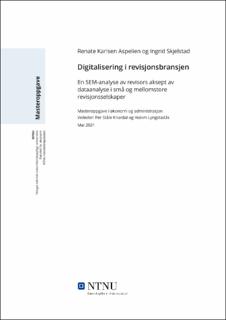| dc.contributor.advisor | Knardal, Per Ståle | |
| dc.contributor.advisor | Lyngstadås, Hakim | |
| dc.contributor.author | Aspelien, Renate Karlsen | |
| dc.contributor.author | Skjelstad, Ingrid | |
| dc.date.accessioned | 2021-09-22T16:04:59Z | |
| dc.date.available | 2021-09-22T16:04:59Z | |
| dc.date.issued | 2021 | |
| dc.identifier | no.ntnu:inspera:82753627:84773289 | |
| dc.identifier.uri | https://hdl.handle.net/11250/2780508 | |
| dc.description.abstract | Revisjonsbransjen er en bransje som vil påvirkes av teknologi i økende grad de neste årene. Revisjon består av mange manuelle og repetitive oppgaver, noe som gjør oppgavene egnet for å digitaliseres. Nye digitaliserte løsninger kan gi muligheten til å erstatte mye av den tradisjonelle revisjonsmetodikken, men for at dette skal kunne skje må brukerne være åpne for å ta i bruk de digitaliserte løsningene. Temaet vårt om digitalisering i revisjonsbransjen er inspirert av dette dilemmaet. Formålet med studien er å undersøke hvorvidt revisorer i små og mellomstore revisjonsselskaper aksepterer bruk av digitalisert dataanalyse, og undersøke hvordan ulike faktorer påvirker revisorenes aksept. Vi har på bakgrunn av dette utledet følgende problemstilling:
«Hvordan kan oppfattet nytte og oppfattet brukervennlighet forklare revisors aksept av dataanalyse i revisjonsprosessen?»
For å besvare problemstillingen er det gjennomført en kvantitativ studie ved bruk av spørreundersøkelse, som er sendt ut til revisorer i små og mellomstore revisjonsselskaper i Norge. Vi utledet ni forskningshypoteser som vi har basert på relevant teori og tidligere forskning, samt utarbeidet en revidert forskningsmodell basert på TAM (Davis, 1989). For å få svar på hypotesene har vi gjennomført en SEM-analyse i LISREL, og fikk totalt 7 av 9 signifikante hypoteser. Vi undersøkte hvordan organisatoriske, sosiale og individuelle faktorer påvirker oppfattet nytte og oppfattet brukervennlighet, som igjen påvirker revisors aksept av dataanalyse. Våre funn viser at organisatoriske og individuelle faktorer har positiv signifikant effekt på nytte og brukervennlighet, samt at sosiale faktorer har negativ signifikant effekt på brukervennlighet. Oppfattet nytte har positiv signifikant effekt på aksept av dataanalyse. I tillegg har oppfattet brukervennlighet positiv signifikant effekt på oppfattet nytte.
Vi har vurdert aksept av dataanalyse etter i hvilken grad revisorene er enige i undersøkelsens indikatorer. Basert på studiens funn aksepterer revisorene digitalisert dataanalyse i den grad at de i gjennomsnitt er enige i hovedvekten av indikatorene som måler aksept. Videre viser forskningsmodellen vår at oppfattet nytte kan forklare revisors aksept, mens oppfattet brukervennlighet ikke alene kan forklare aksept. For at revisors oppfattede brukervennlighet skal kunne forklare revisors aksept, er dataanalyseverktøyet nødt til å være både brukervennlig og nyttig. | |
| dc.description.abstract | The auditing profession is a profession that will be increasingly affected by technology the next years. Auditing is an occupation existing of manual and repetitive tasks which makes the auditing tasks suitable for digitalization. New digitalized solutions can be seen as new possibilities that can replace most of the traditional audit. For this to happen, a crucial part of the process is that users are open and accepting towards the digitalized solutions. The topic of this thesis is digitalization in the audit profession and is inspired by this dilemma. The purpose of the thesis is to look into the auditors’ degree of acceptance of data analysis in small and medium sized auditing companies, and also test different factors that affect the acceptance. Based on this we have made the following research question:
“How can perceived usefulness and perceived ease of use explain the auditors’ acceptance of data analysis in the audit process?”
To answer the research question, we have conducted a quantitative study with the use of a questionary that we sent to auditors in small and medium sized auditing companies in Norway. We deduced nine research hypothesises based on relevant theory and previous research and worked out a revised research model based on TAM (Davis, 1989). To answer the hypotheses, we have conducted a SEM analysis using LISREL, which resulted in a total of 7 out of 9 significant hypotheses.We examined how organizational, social and individual factors affect perceived usefulness and perceived ease of use which then affect acceptance of data analysis. Our findings show that there is a positive significant effect between organizational factors and usefulness, and between organizational factors and ease of use. The same was found for individual factors. A negative significant effect was found between social factors and ease of use. Perceived usefulness has a positive significant effect on acceptance of data analysis. Perceived ease of use has a positive significant effect on perceived usefulness.
We have evaluated acceptance of data analysis by to which degree the auditor is agreeing to the indicators of the study. Based on the thesis’ findings the auditors accept digitalized data analysis to the degree that they agree to the majority of the indicators that measure acceptance. Our research model show that perceived usefulness can explain the auditors’ acceptance, while perceived ease of use by itself cannot. The auditors’ perceived ease of use can only explain acceptance if the data analysis tool is perceived to be both easy to use and useful. | |
| dc.language | nob | |
| dc.publisher | NTNU | |
| dc.title | Digitalisering i revisjonsbransjen | |
| dc.type | Master thesis | |
